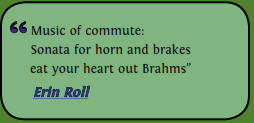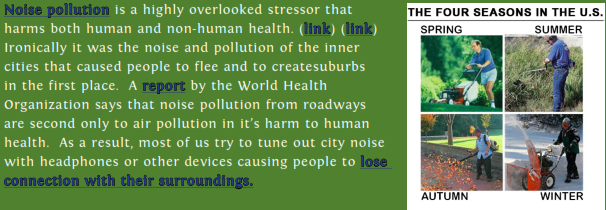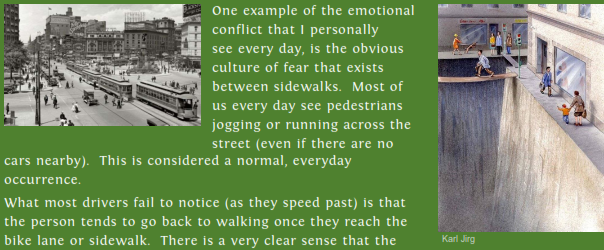Emotional Health





On a similar note, journalist Kathy Freston writes here about helping people let go of their addiction to animal products and to replace harmful habits with more healthy ones. According to Dr. Neal Barnard, ‘our taste cells turn over about every three weeks....in less then a month we forget the attraction to animal products.” (WPD80)
Noise Pollution



Imagine if your daily commute sounded like this Amsterdam street?
Active Learning


road does not belong to people, but to cars. This wasn’t always the case though. Before the 1920s, people saw nothing unusual in walking in or across the street wherever it was convenient. Business interests at the time had a well-documented role in demonizing th use of the road by non-divers.

Loving Dogs and Eating Pigs

Other wonderful sources are John Robbins, author of ‘Diet for a New World,’ and Dr. Will Tuttle author of ‘The World Peace Diet.’ Riane Eisler further explains that the culture we live in is built around domination of animals and ‘resources.’ It requires a deadening of ‘soft emotions’ like compassion which would interfere with acts such as confinement and branding. (WPD20)

“If it’s not good enough for your eyes, why is it good enough
for your stomach?”
Emily, Bite Sized Vegan
Compassionate people (and I think that all of us have a sense of compassion) will fall back on the defence that using animal products which are ‘free range,’ ‘cage free,’ or ‘grass fed’ have no harmful consequences and that makes such products a ‘humane’ alternative. Unfortunately, my research tells a different story. The ranchers who market these alternative food sources may try their best, but the impacts have many of the same harmful consequences as factory farms.
One Green Planet describes the most important ones (some of which are also touched on below). You can read a more detailed description of cattle’s effects on the wild-lands here.

Broccoli Slaughterhouse

As humans, we are uncomfortable with seeing images of animal slaughter and that is a good sign. It shows that “we are not predators. Predators don’t empathize with their prey.” It shows that we are compassionate beings. Think about it this way, which would you feel more comfortable taking a child to, a broccoli harvest, or a slaughterhouse. If you feel horrified by images of a slaughterhouse but not from images of people picking from fruit trees, then this is a powerful clue into what your body naturally wants.
However this essay touches you, I ask only that you take a moment each day to consider the billions of conscious animals which are killed for the sake of the human diet, and think about whether you want to support that in your life.


average, as measured in lost workdays. If you accept the official figures, about 40,000 meatpacking workers are injured on the job every year (the industry regularly minimizes these figures). (link)
What is Solastalgia?

since the term ‘ozone hole’ first entered the public’s eye. (link) Through the work of Dr. Berry and other researchers, the awareness of depression and solastalgia stemming from a more hostile climate are finally becoming more fully understood.

Desperately Seeking Space

the emotional health of people. The critical link between our emotional health and access to natural areas has been well proven by dozens of studies. (link) (link)
I remember clearly as a teenager living in Los Angeles and struggling to get out to a natural area. I would ride my bike for most of the day (as much as 50 miles out) and still not end up leaving the ‘developed’ part of the city. Suburbia consumed nearly every square mile of land beyond the city center.























